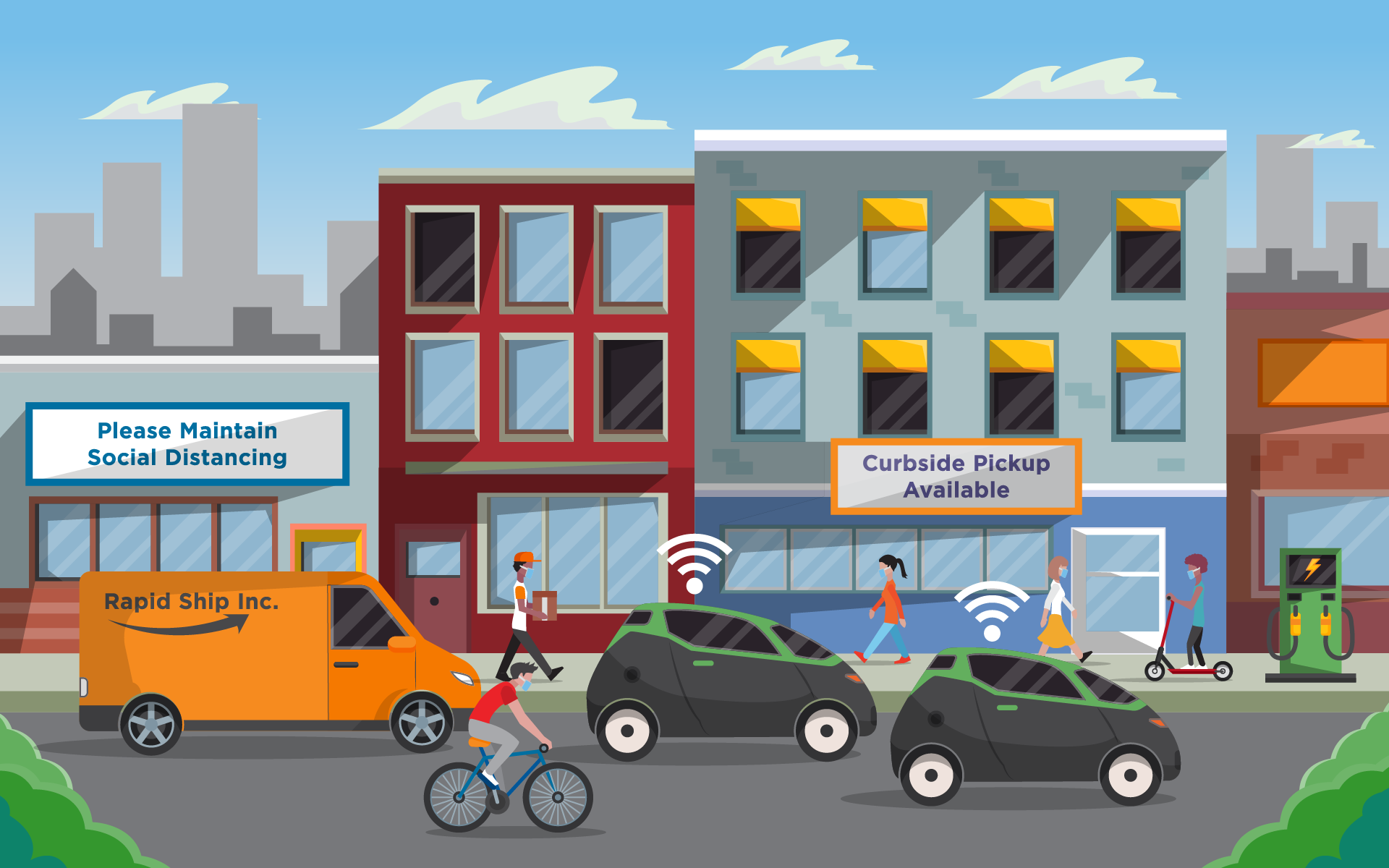Large sectors of the economy and certain types of travel remain grounded nearly one year after the start of the pandemic. Vaccines offer hope, but findings from RSG’s COVID-19 Transportation Insights Panel suggest the impacts on travel behaviors and attitudes are likely to be lasting. For example, among travelers who took at least one air trip in 2019, only 35% stated that they would fly at least yearly in a scenario with a vaccine available and cases that were decreasing but with no additional public health measures in place.
No industry has been immune to the pandemic and its effects. However, COVID-19 hit the transportation industry at a pivotal moment. Several technological trends, collectively referred to as ACES (Autonomous, Connected, Electrified, and Shared), are poised to disrupt, or are already disrupting, the mobility market.
The pandemic-induced downturn may mean that companies need to stop or reprioritize technology investments. This will produce short-term impacts as well as aftershocks that will affect several well-known future mobility technologies associated with ACES.
Autonomous Vehicles
In the short term, the pandemic has negatively affected many of the companies investing and working in the autonomous vehicle (AV) space. Uber recently sold its self-driving unit to a start-up, a move undoubtedly linked to the pandemic battering its core ride-hailing business. Testing and deployment of AVs was also temporally suspended in March by Waymo, Cruise, Pony.ai, and others.
Despite these challenges, the pandemic has also highlighted opportunities for AVs to serve as a solution in times of social distancing and contactless delivery. Earlier this year, the National Highway Traffic Safety Administration granted autonomous delivery company Nuro a temporary exemption from certain federal requirements on low-speed driverless vehicles. The exemption applies to Nuro’s R2, a zero-occupant, low-speed electric delivery vehicle designed to carry consumer products such as groceries, packages, and restaurant orders.
Two other AV companies, Beep and NAVYA, partnered with the Jacksonville Transportation Authority to transport COVID-19 tests via autonomous shuttles to protect frontline hospital workers and patients. Other examples abound of new AV use cases during the pandemic, including AVs facilitating contactless last-mile food deliveries to those in need and keeping supply chains intact with long-haul driverless commercial trucks.
Use cases for contactless delivery also extend to other types of autonomous vehicles, such as drones and sidewalk delivery bots. For example, a pilot project between UPS and CVS has used drones for prescription medicine deliveries in The Villages, Florida’s largest retirement community. Maintaining the current pace of AV development depends heavily on continued investment.
The pandemic may end up delaying the timeline for AVs as companies are forced to reconcile research and development costs with reduced bottom lines. However, while COVID-19 has slowed new vehicle sales and may delay the development of AV technology, it has also increased interest in and adoption of AV technology in other spaces.
Electric Vehicles
Despite global auto sales plunging during the pandemic, electric vehicle (EV) sales are estimated to reach a record share of the overall car market. The International Energy Agency predicts that EVs will account for 3% of global car sales in 2020, surpassing the 2019 record of 2.6%.
One indicator hinting the 2020s will be the decade of the electric motor is the incredible level of market investment in both EVs and electric vehicle supply equipment companies. Although the stock market as a whole has rebounded since its March lows, EV stocks have fared exceptionally well. A few examples at the time of this writing include Tesla (NASDAQ: TSLA), which is up 872% in the past year, Chinese EV-maker NIO (NYSE: NIO) up by 2,011%, and Blink Charging (NASDAQ: BLNK) up by 1,324%.
The trends set in motion before COVID-19 favoring electrification, such as more stringent regulations on the internal-combustion engine (ICE) and investment in EVs by automakers, remain strong drivers of EV sales and adoption. For example, California issued a mandate in September 2020 that all new passenger cars and trucks sold in the state will be zero-emission vehicles by 2035, which will help push the US market as a whole toward EVs given California’s size.
Interestingly, the ho-hum hybrid has proven resilient and is seeing a resurgence in major markets. The reasons for this are many. For one, hybrids are more affordable than fully electric vehicles and offer cost savings at the pump when compared to their ICE counterparts. And unlike fully electric vehicles, they do not induce range anxiety or require a dedicated parking space for charging. In other words, despite the fact that ranges and charging times are quickly improving for fully electric vehicles, some Americans may still perceive hybrids as more accessible and practical, especially during a time of economic hardship. Eventually, hybrids will cede some market share to fully electric vehicles, but in the short term they are forecast to grow at a faster pace.
Shared Mobility
Shared mobility has been hit the hardest by the pandemic. Even as stay-at-home orders were lifted, monthly transit ridership in July was down almost 65% from the previous year, according to data from the National Transit Database.
Ride-hailing has not fared much better. Bleak quarterly reports from Uber and Lyft have shown trip bookings down by as much as 80% at the height of lockdowns. More recently, ride-hailing services have begun to bounce back, but revenue estimates for Uber’s third-quarter, published in November, still show revenue from its ride-hailing division down by 50% year over year.
Micromobility services, or shared systems of e-scooters and conventional and e-bikes, have been the most resilient shared mode during the pandemic. Notwithstanding drops in ridership during lockdowns, micromobility bounced back quicker. These modes allow users to socially distance and likely benefited from street closures and reduced traffic due to more people teleworking.
Several cities, including Oakland, Seattle, and Minneapolis took advantage of reduced traffic to create networks of “slow streets” with vehicle access limited to residents and deliveries. These modes will also continue to benefit from public investment in bicycle infrastructure.
However, research by RSG shows that even in the most optimistic scenarios of recovery, with vaccines widely used, few new cases, and health measures in place, a significant portion of users state an unwillingness to return to some shared modes. During the latest round of RSG’s COVID-19 Transportation Insights Panel survey, 12% of transit riders and 11% of ride-hailing users who previously used the services at least weekly or monthly (respectively) were unwilling to return to these modes at their previous frequencies even in the “best case” scenario.
What’s Next for Future Mobility?
Overall, it is unlikely ACES trends will slow down due to the pandemic. In fact, EVs have shown to be resilient in the face of overall declining auto sales. Other technologies, including AVs and micromobility, have proven to be useful tools for improving community resilience and connectivity during times of crisis and uncertainty.
Planners and other decision-makers in the transportation space should continue to monitor these developments to better leverage any associated opportunities and mitigate risks in shaping the future of mobility. For example, preparing a future mobility plan is one way agencies and governments can prepare for and respond to the technological transformations connected to ACES.
Remaining informed and being proactive is essential. When it comes to ACES, knowledge and planning will help transportation systems and our communities bounce back stronger from the current crisis and become more resilient when faced with the next one.



